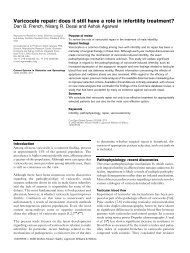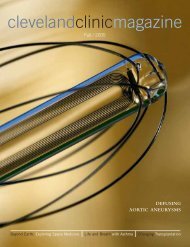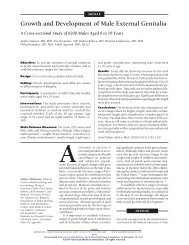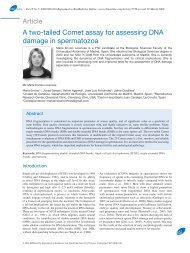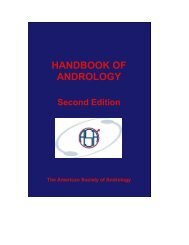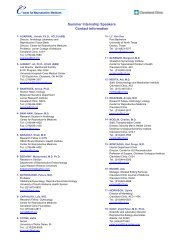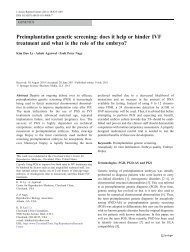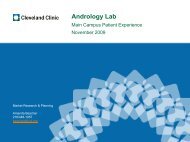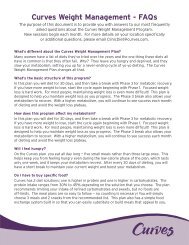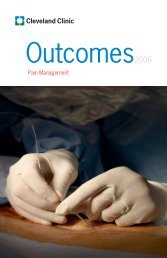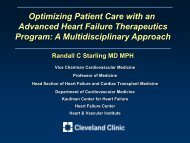Artificial Insemination
Artificial Insemination
Artificial Insemination
You also want an ePaper? Increase the reach of your titles
YUMPU automatically turns print PDFs into web optimized ePapers that Google loves.
Ch36-A03309.qxd 1/23/07 5:16 PM Page 542<br />
Section 6<br />
Infertility and Recurrent Pregnancy Loss<br />
542<br />
has no viable sperm (i.e., azoospermia) or when IVF/ICSI fails<br />
to achieve fertilization. Finally, men with a known genetic<br />
disorder often choose donor insemination to avoid transmission<br />
to their children.<br />
Donor Selection<br />
Couples choose a donor from profiles of nonidentifiable<br />
information. This information usually includes racial or ethnic<br />
background, blood type, physical characteristics, and certain<br />
social characteristics. Many women who become pregnant as a<br />
result of donor insemination desire to use the same donor for<br />
further pregnancies.<br />
Donor Evaluation<br />
Thorough evaluation of all potential sperm donors (other than<br />
sexually intimate partners) is necessary to avoid inadvertent<br />
transmission of sexually transmitted diseases or known genetic<br />
syndromes. 16 All donors undergo a review of relevant medical<br />
records, personal and family history, and a physical examination.<br />
Determination of normal semen characteristics is extremely<br />
important. In addition, blood grouping and karyotyping is<br />
performed.<br />
Each donor must be screened for risk factors and clinical<br />
evidence of communicable diseases, including:<br />
● human immunodeficiency virus types 1 and 2<br />
● human T-lymphotropic virus types I and II<br />
● hepatitis B and C<br />
● cytomegalovirus<br />
● human transmissible spongiform encephalopathy (including<br />
Creutzfeldt-Jakob disease)<br />
● Treponema pallidum<br />
● Chlamydia trachomatis<br />
● Neisseria gonorrheae<br />
If the donor is deemed acceptable and is aware of the ethical<br />
and legal implications, semen can be collected. All donor semen<br />
samples are cryopreserved and quarantined for 6 months. Before<br />
a donor sample is used for insemination, the donor is retested<br />
and determined if eligible.<br />
Success Rate<br />
The actual per cycle fecundity rate with donor IUI is dependent<br />
on multiple factors. A meta-analysis of seven studies demonstrated<br />
that IUI yielded a higher pregnancy rate per cycle<br />
than intracervical insemination with donor frozen sperm. 17<br />
Overall, the average live birth rate per cycle of donor IUI is<br />
approximately 10%. 18<br />
IUI TIMING, COST, AND FREQUENCY<br />
Timing<br />
Timing of insemination in relationship to ovulation is one of the<br />
crucial factors in the success of IUI. Although viable sperm<br />
remain in the female reproductive tract for up to 120 hours<br />
after coitus, the best pregnancy rates are obtained when IUI is<br />
performed as close as possible to ovulation. 19,20<br />
In the past, IUI was performed on the estimated day of<br />
ovulation based on basal body temperature rises during previous<br />
cycles. However, to optimize fecundity, modern prospective<br />
timing strategies are based on either detection of a urinary LH<br />
surge or administration of an ultrasound-timed dose of human<br />
chorionic gonadotropin (hCG ) to trigger ovulation.<br />
LH Surge<br />
A commonly used method for timing of IUI is based on urinary<br />
LH measurement. Ovulation occurs 40 to 45 hours after the<br />
onset of the LH surge. 21 <strong>Insemination</strong> is thus planned for the<br />
day after detection of a rise in urinary LH. This approach offers<br />
the simplest and most cost-effective of the indirect methods<br />
for predicting ovulation and is just as effective in achieving<br />
pregnancy as more complex ones. 22,23<br />
Ultrasound and Human Chorionic Gonadotropin<br />
Transvaginal ultrasonography is widely used to monitor the size<br />
of the follicles and to assess the timing of ovulation. Follicles<br />
become recognizable once they grow to 2 to 3 mm in diameter.<br />
After 8 mm, linear follicular growth occurs at a rate of approximately<br />
2 to 3 mm per day. Ovulation occurs during a natural<br />
cycle when the lead follicle reaches 15 to 24 mm in size.<br />
Injection of hCG can be given to induce predictable ovulation<br />
when at least one follicle diameter is between 17 and 21 mm.<br />
For optimal pregnancy rates, IUI is scheduled 24 to 36 hours<br />
after the injection.<br />
IUI Cost<br />
The cost-effectiveness of the treatment is an important consideration<br />
when deciding on the most appropriate infertility<br />
treatment option. 24 The cost of insemination varies from clinic<br />
to clinic, but is presently less than $500 per IUI, including sperm<br />
preparation and injection of the prepared sample. This compares<br />
favorably with the cost of other appropriate ART approaches.<br />
Even when the cost of ovulation induction medication and<br />
monitoring are included, the cost per live birth for IUI after<br />
superovulation has been calculated to be less than half the cost<br />
of IVF treatment. 25<br />
IUI Frequency<br />
It is recommended that IUI be performed either one or two<br />
times during each cycle. Performing two inseminations per cycle<br />
is likely to be especially advantageous when timing in relationship<br />
to ovulation is less precise. Although it seems intuitive that<br />
fecundity should be increased by two inseminations per cycle, it<br />
remains inconclusive whether the increased fecundity is worth<br />
doubling the patients’ cost and inconvenience compared to one<br />
insemination per cycle. 26–30 A recent meta-analysis of more than<br />
1000 IUI cycles revealed a slightly higher but statistically<br />
insignificant difference between the per cycle fecundity rate for<br />
two inseminations (14.9%) compared to one insemination per<br />
cycle (11.4%). 31 Accordingly, one well-timed insemination appears<br />
to offer the best balance between efficacy and cost.<br />
SPERM PREPARATION FOR IUI<br />
Sperm preparation methods are used to process semen samples<br />
such that viable sperm are separated from seminal plasma. This<br />
is necessary before IUI to avoid the consequences of intrauterine<br />
injecting of semen plasma proteins and prostaglandins. 32<br />
Although seminal plasma protects the spermatozoa from stressful



